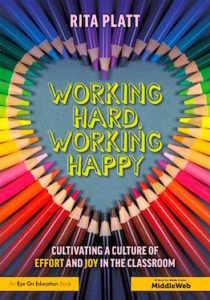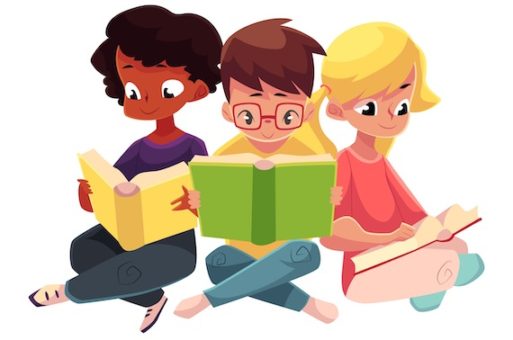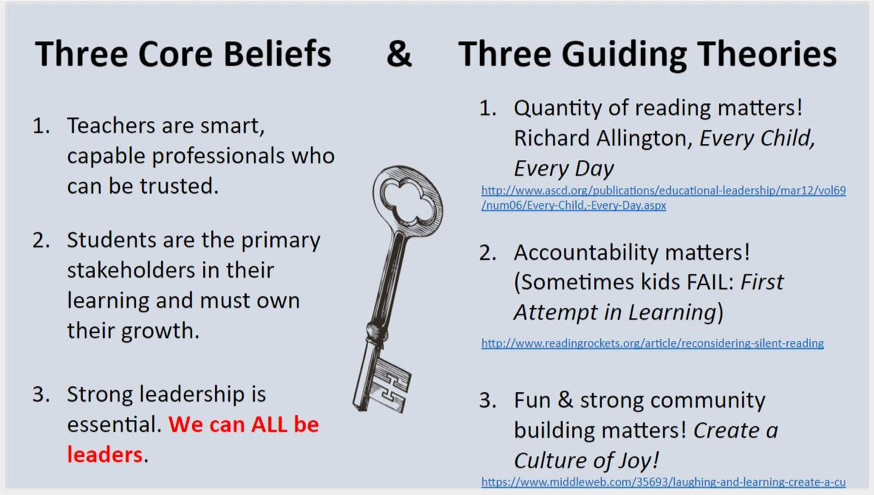Let Students Read! Why Quantity Really Counts
A MiddleWeb Blog
 If we want our students to be readers, we have to let them read. We have to freely give them time for the kind of reading that is guided by curiosity, joy, and desire to fall deep into story. Pleasure reading. Real reading.
If we want our students to be readers, we have to let them read. We have to freely give them time for the kind of reading that is guided by curiosity, joy, and desire to fall deep into story. Pleasure reading. Real reading.
As a long-time educator and a self-proclaimed book nerd, I believe that educators must support and encourage real reading. That is our job. We must help our students become lifelong connoisseurs of text. It’s a simple concept. It’s a big deal.
Most teachers know that the quantity of reading impacts not only how well students read but also how much general knowledge they possess. Moreover, the research is in: folks who read a lot tend to be more empathetic, and as teachers we know, maybe better than anyone else, that we need more empathy in the world.
So, what can we do to get our kids to read more? That’s simple too. We can let them read.
Independent reading in schools must be more than just an ad-hoc, when-you’re-finished-with-your-work, kind of thing. In the best case, it needs to be even more than just a dedicated time slot for independent reading.
In her amazing book, Literacy Essentials, Regie Routman explains that for maximum impact, schools must value massive quantities of free reading and students must be taught to choose just-right books (books they can and want to read) and to self-monitor for comprehension.
Further, Regie advises that teachers should be teaching during free reading time, working with students one on one to help them learn reading skills and strategies and also to help them choose, discuss, and enjoy texts.
Learning to love books
I am a veteran elementary and secondary reading teacher and now the principal of St. Croix Falls and Dresser Elementary Schools in rural Wisconsin. We serve a wonderful community that includes an increasing number of students who live in poverty. Despite that fact, we consistently are marked as “Exceeding Expectations” on the state report card and have literacy scores that place us in the top 5% of schools in the state.
Perhaps most important, there is no literacy gap between our students of poverty and their more affluent peers. We are all good readers and writers.
Over the last several years I’ve had many schools reach out to ask how we are so successful. I always say the same thing: “We let kids read. A lot.”
In our schools every student enjoys a minimum of 30 minutes of free reading time each day. Most days, students have closer to an hour. Right away, beginning in kindergarten, we offer students books, books, books and time to read them.
We teach students to pick books that fit their interests and that are within a level that is accessible to them (yes, we level our books; no, it doesn’t limit our readers or kill their love of reading.)
I believe our emphasis on helping students learn to love to read in massive quantities is why my school is one of the happiest and most successful schools I have ever had the pleasure of working in. And that’s what I tell folks who ask “how we do it.”
But guess what? They don’t always believe me. They are often incredulous and profess they don’t have enough hours in the day to offer that much independent reading time. They need that time to “teach” kids to read.

All educators need to do is give kids time and let them read. Anthologies, lesson sets, interventions, strategy instruction, guided groups, phonics, word study, and all of the other best laid plans of reading teachers will not work if they are not grounded in opportunities for real reading.
Let. Students. Read.
The reading drop
My school is successful in large part because our students read. They read a lot. But that tends to drop off as kids enter middle and high school. Of course, that’s not just in my neck of the Wisconsin woods; it happens in school districts all over the nation.
A recent Edutopia article cited the following statistic from a study on the reading lives of school-aged children: “53 percent of 9-year-olds were daily readers, but only 17 percent of 17-year-olds were.” Why? In large part, I think, it’s because as our children move through the grades they have less and less dedicated reading time scheduled into their day.
They read in content classes and in a literature course or two, but they do not have time for choice-based pleasure reading. That’s a problem. Again, if we want kids to read, we have to give them time to read.
Suggestions
1. Create a vision statement or set of guiding beliefs about literacy in your school or classroom.
Below is a graphic that shows the philosophies that underpin literacy instruction at my school. Note: The three mentioned documents are here (1), here (2), and here (3).
2. Allow students time to read in school every day and in every grade.
A good friend, who is a high school English teacher, recently told me that for the first time this year, she allowed students to self-select a novel to read in class. She raved about a boy who told her, “This was the first book I finished since elementary school!”
Imagine if her school could find a way to adjust the schedule so that every student had 20 minutes for independent reading every day! 100 minutes a week! 400 minutes a month! Almost 7 hours!
3. Let go of programs and buy books.
In an article I wrote for Educational Leadership, I detail the path my school took to move from good to great. One thing we didn’t do was buy a new program. Instead, we used what we had to help us build a culture that celebrated reading with a focus on time for choice reading.
To support this effort, we spent time and money developing quality classroom libraries. Building classroom libraries can be done on the cheap by requesting donations (I often remind parents and others that I welcome their gently used books and keep a tote in the school lobby for donations), thrift shopping and garage sales, and inexpensive booksellers (First Book Marketplace and Scholastic Book Clubs are good starts).
4. Teach students to set and meet their own literacy goals.
Helping students see themselves as capable readers who have autonomy over their own reading lives is a gift. Readers at my school set quarterly goals; read about how here. It has been truly amazing to watch students continually raise their own bars, meet lofty goals, and enjoy the sense of pride and accomplishment that comes with it.
5. Build a school culture that supports literacy as a natural part of daily life.
Strategies we’ve used include encouraging volunteers to read with students and share their own reading lives, helping students to “Binge Read,” getting free books into the community, using social media to create a community of readers, hosting virtual and/or face-to-face author visits, and harnessing the power of social learning to help students view reading as a normal life thing, not just a school thing.
The bottom line is that if you want readers, it’s not that hard to get readers! Just let them read!
_______________________________________








































